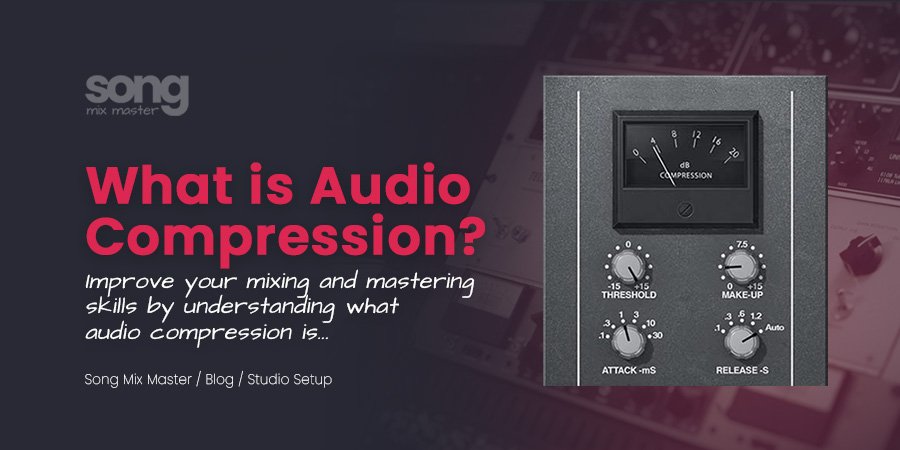Hey there, fellow audio enthusiasts! As a mixer and mastering engineer, I can’t stress enough how vital compression is in shaping the dynamics and overall sound of your mix.
In this new comprehensive guide, you will find some expert tips to improve your mixing and mastering skills by understanding what compression is, how many types of compression are there, and how it works.
What is Audio Compression?
Audio compression is a dynamic range control technique used to reduce the volume of loud sounds or amplify quiet sounds, thereby controlling the overall dynamic range of an audio signal. This ensures a more balanced and polished sound, which is essential for professional audio production.

Types of Audio Compression
Downward Compression
Downward compression is the most common type of compression. It reduces the volume of signals that exceed a certain threshold. This technique is primarily used to control peaks and make the overall volume more consistent.
- Application: Great for taming loud transients in vocals, drums, and other instruments.
- Tip: Be cautious with the threshold and ratio settings to avoid squashing the dynamics too much.
Upward Compression
Upward compression boosts the volume of signals below a certain threshold. This technique helps bring out the details in quieter passages, making the mix fuller and more engaging.
- Application: Ideal for enhancing the nuances in background vocals, acoustic instruments, and ambient sounds.
- Tip: Use upward compression to add warmth and presence to softer elements without overwhelming the mix.
One of my favorite plugins for upward compression is the Xfer OTT or Waves MV-2 compressor.
Also, check out my list of the Best Free Compressor VST Plugins
Multiband Compression
Multiband compression splits the frequency spectrum into multiple bands and compresses each one individually. This allows for targeted control over specific frequency ranges, making it particularly useful in mastering.
- Application: Perfect for balancing the low, mid, and high frequencies of a mix or master.
- Tip: Use multiband compression to fix problematic frequencies without affecting the entire mix.
Also read: Multiband Compression: Techniques, Tips, and Top Plugins
Sidechain Compression
Sidechain compression is driven by an external signal (the sidechain) rather than the signal being compressed. A common example is the “pump” effect in electronic music, where the bass volume is reduced whenever the kick drum hits.
- Application: Essential for creating space in dense mixes, especially in electronic and dance music.
- Tip: Experiment with sidechain compression to add rhythmic elements and movement to your mix.
Go deeper: What Is Sidechain Compression – Why Use Sidechain Compression
Parallel Compression (New York Compression)
Parallel compression involves blending a heavily compressed signal with the original, uncompressed signal. This technique preserves the natural dynamics while increasing overall loudness and density.
- Application: Great for drums, vocals, and full mixes to add punch and thickness without losing dynamics.
- Tip: Use parallel compression to add impact and clarity, particularly in rock and pop mixes.
Also read: What Is Parallel Compression & How To Use It
“Glue” Compression
“Glue” compression is a technique often used on the mix bus or group channels to create a more cohesive sound. Applying gentle compression to the entire mix or a group of instruments helps to “glue” the different elements together, making the mix sound more cohesive.
- Application: Commonly used in the final audio mastering stage to ensure all elements of the mix work together seamlessly.
- Tip: Apply light compression with a low ratio and slow attack and release times to avoid over-compressing the mix.
Go deeper: “Glue” Compression – Best Glue Compressors for Mastering
Investing in high-quality compressor plugins can be a game-changer for your productions. These plugins often offer unique tonal characteristics and advanced features that stock plugins lack.
Look for user-friendly interfaces and compatibility with your DAW. Features like sound coloration and oversampling can provide added benefits.
Having a range of best compressor plugins allows you to be more flexible and creative in different mixing scenarios.
Common Mistakes and How to Avoid Them
Over-Compression
One of the most common mistakes is over-compression, which can lead to a lifeless and flat sound. Always use your ears and aim for transparency. If the compression is too noticeable, back off the threshold or ratio until the track breathes naturally.
Ignoring the Release Time
Setting the release time incorrectly can cause pumping or breathing effects. Listen carefully and adjust the release to match the tempo and feel of the track. For slower tracks, a longer release often works better, while faster tracks may benefit from a quicker release.
Not Using Make-Up Gain
Compression reduces the overall volume of a track, so use make-up gain to bring the level back up. This ensures that the compressed signal sits well in the mix without losing its presence.
In Conclusion
Compressors are indispensable tools in music production and audio post-production. They help manage dynamics, enhance details, and contribute to a polished, professional sound.
By mastering various compression techniques and investing in quality compressor plugins, you can ensure your productions sound their best.
Also read: Learn Audio Compression With “The Anticipation Method”


Disclaimer: Any references to any brands on this website/webpage, including reference to products, trademarks, brands and companies, are provided for description purposes only. We don't have any association with or endorsement by these brands or companies. Some of the links on our blog may be affiliate links. This means if you click on these links and make a purchase, we may earn a commission at no extra cost to you.
Need Professional Mixing & Mastering?
You may also like to read...
Review of the Empirical Labs EL8 Distressor Plugin by UAD
Audio Clipping in Music: Causes, Consequences, and Solutions
Editing Vocals: Best Tips for Preserving The Natural Vocal Sound
Best Reference VST Plugins for Comparison (A/B Plugins)
Mixing Vs. Mastering – Explaining The Main Differences
How To “Glue” Your Mix Using the SSL Bus Compressor by Waves